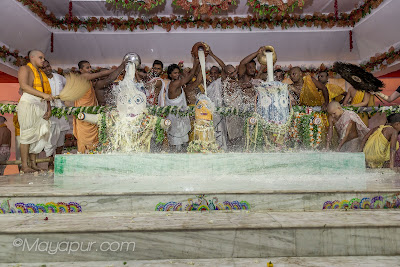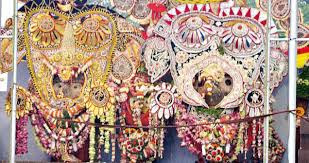This bathing ceremony is believed to be a tribal ceremony and has a specialty. The Daitas and the people of Savaras tribe have the exclusive right to conduct the festival. The tribal called Saoras from southern Orissa performs a rite to bathe their Deities ceremonially on the last day of the month of Jyestha. For this, they collect water from remote jungles where it remains untouched even by the shadows of animals.
On the fourteenth day (Chaturdashi) , The Deities are taken out in procession, the whole process is called Pahandi or Pahandi-Vijaya. For the festival, the Snana Vedi (bathing platform) is well decorated with traditional paintings of trees, and gardens along with Flags and flower arches. The Deities are decorated with flowers. All kinds of perfumed items such as incense, oils, etc. are then offered.
Then the next day on Purnima day after Mangala Arati, the Suaras and Mahasuaras go in a ceremonial procession to fetch water from Golden Well in one hundred and thirty vessels of copper and gold. All of them cover their mouths with a piece of cloth so as not to contaminate it, even with their breath. Then all the vessels filled with water are preserved in the Bhoga Mandapa. The Palla-pandas then purify the water with turmeric, whole rice, Benachera, sandalwood, Aguru, flowers, perfumes, and medicinal herbs. The filled vessels are carried from the Bhoga Mandapa to the Snana Vedi by the Suaras in a long single-line procession. This water is called ‘Jaladhivasa’ water, and the ritual is called Jalabhiseka.
Due to the number of bathing liquids that are offered to cool the Lord’s transcendental body at the hottest time of the summer in India, Lord’s painted body becomes a bit washed out. This is the time when Lord Jagannath along with Baladev and Subadra are traditionally believed to fall ill and are kept in a sick room to recuperate in privacy under the care of the Raj Vaidya. this period is known as Anasara the Gods cannot be seen by devotees. During ‘Anavasara’, the Daitas offer to the Deity only fruits and water mixed with cheese, and dasa-mula medicines that is made from spices and herbs like pepper, cardamom, tulsi leaves, sandalwood, rose petals, water from the Ganges and rose water to help them cure His fever. In a devotional mood, the devotees accept that due to all the bathing the Lord becomes transcendentally tired, and therefore needs to take rest. Somewhat like human beings, They are considered to have ‘fallen ill’ and are treated by the Raja Vaidya or the Royal Physician with specific medicines (dasa-mulas) the deities are fed specially prepared ‘Kadha’ illness. This bitter kadha is offered as prasad to the devotees who visit the temple in the hope to keep the dreaded ailments at bay. This kadha has anti-fever, anti-malarial, pain-reliever, and digestive properties.
Along with the offering of kadha. Because the deities become a bit discolored due to so much bathing with water Seeing the wooden Deities in discolor, some devotees may not have the appropriate devotional attitude and may in fact feel sinful repugnance. so the Deities are kept away from public view for fifteen days and during all these days the daily rites of the temple remain suspended.
The Deities are kept in a special “sick room” called the Ratana Vedi inside the Temple. This period is called ‘Anavasara-Kala‘, meaning improper time for worship. During these fifteen days, the Daitas (descendants of Visvavasu, the Savara) repaint and restore the Deities and Jagannatha’s fine decorations using only natural earthly mineral paints, not modern oil-based paints. The period of coloring and decorating the Deities is divided into seven short periods, each of two days duration, and a short period of one day set apart to give finishing touches. Thus the period covers the whole fortnight. On the 16th day the Deities in their newly appearing forms after renovation become ready for the public Darsana.


